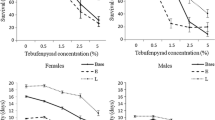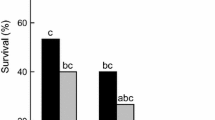Abstract
In the present study we test whether variation in resistance to paraquat (PQ), a free radical generator, correlates with variation in longevity in two sets of seed beetles (Acanthoscelides obtectus) experimental lines that were selected either for early reproduction and short-life or late reproduction and long-life. Long-lived late reproduction lines (L) showed increased resistance to PQ, while opposite was true for short-lived early reproduction line (E). Striking outcome of the selection for early and late reproduction in A. obtectus is asymmetry of responses to alternate mating schedules. The intensity of response depended on selection regime, sex and PQ dose. Evolution of longevity and PQ resistance was faster in L than E selection regime, and in females than males. To understand how age-specific mortality rates are affected by PQ we decomposed post-stress mortality data (using Gompertz mortality model) into initial mortality rate, which reflects basal vulnerability to stresses and age-specific mortality rate, which concerns the rate of increase in stress vulnerability, i.e. the rate of senescence. By estimating the parameters of the Gompertz mortality model we have shown that longevity reduction caused by PQ was the consequence of the increased baseline mortality rather than a speed up of the rate of ageing.





Similar content being viewed by others
References
Arking R, Buck S, Berrios A, Dwyer S, Baker GT (1991) Elevated paraquat resistance can be used as a bioassay for longevity in a genetically based long-lived strain of Drosophila. Dev Genet 12:362–370
Arking R, Buck S, Novoseltev VN, Hwangbo D-S, Lane M (2002) Genomic plasticity, energy allocations, and the extended longevity phenotypes of Drosophila. Ageing Res Rev 1:209–228
Arosio P, Ingrassia R, Cavadini P (2009) Ferritins: a family of molecules for iron storage, antioxidation and more. Biochim Biophys Acta 1790:589–599
Bonilla E, Medina-Leendertz S, Villalobos V, Molero L, Bohórquez A (2006) Paraquat-induced oxidative stress in Drosophila melanogaster: effects of melatonin, glutathione, serotonin, minocycline, lipoic acid and ascorbic acid. Neurochem Res 31:1425–1432
Camus MF, Clancy DJ, Dowling DK (2012) Mitochondria, maternal inheritance, and male aging. Curr Biol 22:1717–1721
Chaudhuri A, Bowling K, Funderburk C, Lawal H, Inamdar A, Wang Z, and O’Donnell JM (2007) Interaction of genetic and environmental factors in a Drosophila Parkinsonism model. J Neurosci 27:2457–2467
Cocheme HM, Murphy MP (2008) Complex I is the major site of mitochondrial superoxide production by paraquat. J Biol Chem 283:1786–1798
Curtsinger JW, Khazaeli AA (2002) Lifespan, QTLs, age-specificity, and pleiotropy in Drosophila. Mech Ageing Dev 123:81–93
Driver C, Tawadros N (2000) Cytoplasmic genomes that confer additional longevity in Drosophila melanogaster. Biogerontology 1:255–260
Frankham R (1990) Are responses to artificial selection for reproductive fitness characters consistently asymmetrical? Genet Res 56:35–42
Fukushima T, Tanaka K, Lim H, Moriyama M (2002) Mechanism of cytotoxicity of paraquat. Environ Health Prev Med 7:89–94
Geiser DL, Winzerling JJ (2012) Insect transferrins: multifunctional proteins. Biochim Biophys Acta 1820:437–451
Gems D, Partridge L (2013) Genetics of longevity in model organisms: debates and paradigm shifts. Annu Rev Physiol 75:25.1–25.24
Grönke S, Clarke D-F, Broughton S, Andrews TD, Partridge L (2010) Molecular evolution and functional characterization of Drosophila insulin-Like peptides. PLoS Genet 6:e1000857. doi:10.1371/journal.pgen.1000857
Harshman LG, Haberer BA (2000) Oxidative stress resistance: a robust correlated response to selection in extended longevity lines of Drosophila melanogaster? J Gerontol 55A:B415–B417
Harshman LG, Moore KM, Sty MA, Magwire MM (1999) Stress resistance and longevity in selected lines of Drosophila melanogaster. Neurobiol Aging 20:521–529
Jimenez-Del-Rio M, Daza-Restrepo A, Velez-Pardo C (2008) The cannabinoid CP55,940 prolongs survival and improves locomotor activity in Drosophila melanogaster against paraquat: implications in Parkinson’s disease. Neurosci Res 61:404–411
Khazaeli AA, Nuzhdin SV, Curtsinger JW (2007) Genetic variation for life span, resistance to paraquat, and spontaneous activity in unselected populations of Drosophila melanogaster: implications for transgenic rescue of life span. Mech Ageing Dev 128:486–493
Kirkwood TBL, Kowald A (2012) The free-radical theory of ageing—older, wiser and still alive. BioEssays 34:692–700
Lazarević J, Tucić N, Šešlija Jovanović D, Večeřa J, Kodrík D (2012) The effects of selection for early and late reproduction on metabolite pools in Acanthoscelides obtectus Say. Insect Sci 19:303–314
Min K-J, Tatar M (2006) Restriction of amino acids extends lifespan in Drosophila melanogaster. Mech Ageing Dev 127:643–646
Minois N (2001) Resistance to stress as a function of age in transgenic Drosophila melanogaster overexpressing Hsp70. J Insect Physiol 47:1007–1012
Missirlis F, Hu J, Kirby K, Hilliker AJ, Rouault TA, Phillips JP (2003) Compartment-specific protection of iron-sulfur proteins by superoxide dismutase. J Biol Chem 278:47365–47369
Mockett RJ, Orr WC, Rahmandar JJ, Sohal BH, Sohal RS (2001) Antioxidant status and stress resistance in long- and short-lived lines of Drosophila melanogaster. Exp Gerontol 36:441–463
Mockett RJ, Bayne AÉV, Kwong LK, Orr WC, Sohal RS (2003) Ectopic expression of catalase in Drosophila mitochondria increases stress resistance but not longevity. Free Radic Biol Med 34:207–217
Mohammadi-Bardbori A, Ghazi-Khansari M (2008) Alternative electron acceptors: proposed mechanism of paraquat mitochondrial toxicity. Environ Toxicol Pharmacol 26:1–5
Morrow G, Samson M, Michaud S, Tanguay RM (2004) Overexpression of the small mitochondrial Hsp22 extends Drosophila life span and increases resistance to oxidative stress. FASEB J 18:598–599
Mourikis P, Hurlbut GD, Artavanis-Tsakonas S (2006) Enigma, a mitochondrial protein affecting lifespan and oxidative stress response in Drosophila. Proc Natl Acad Sci USA 103:1307–1312
Nichol H, Law JH, Winzerling JJ (2002) Iron metabolism in insects. Annu Rev Entomol 47:535–559
Orr WC, Radyuk SN, Prabhudesai L, Toroser D, Benes JJ, Luchak JM, Mockett RJ, Rebrin I, Hubbard JG, Rajindar S, Sohal RS (2005) Overexpression of glutamate-cysteine ligase extends life span in Drosophila melanogaster. J Biol Chem 280:37331–37338
Pham DQD, Winzerling JJ (2010) Insect Ferritins: typical or atypical? Biochim Biophys Acta 1800:824–833
Pletcher SD (1999) Model fitting and hypothesis testing for age-specific mortality data. J Evol Biol 12:430–439
Rattan SIS (2012) Biogerontology: from here to where? The Lord Cohen Medal Lecture—2011. Biogerontology 13:83–91
Ruan H, Tang XD, Chen M-L, Joiner M-LA, Sun G, Brot N, Weissbach H, Heinemann SH, Iverson L, Wu C-F, Hoshi T (2002) High-quality life extension by the enzyme peptide methionine sulfoxide reductase. Proc Natl Acad Sci USA 99:2748–2753
SAS Insitute, Inc. (2004) The SAS System for Windows. Release 9.1. SAS Institute, Cary
Seehuus S-C, Norberg K, Gimsa U, Krekling T, Amdam GV (2006) Reproductive protein protects functionally sterile honey bee workers from oxidative stress. Proc Natl Acad Sci USA 103:962–967
Šešlija D (2005) Analysis of the selection effects on fitness components in the bean weevil (Acanthoscelides obtectus). Doctoral dissertation, University of Belgrade
Šešlija D, Tucić N (2008) The genetic architecture of extended life span in the seed beetle Acanthoscelides obtectus (Coleoptera, Bruchidae). Eur J Entomol 105:553–560
Šešlija D, Blagojević D, Spasić M, Tucić N (1999) Activity of superoxide dismutase and catalase in the bean weevil (Acanthoscelides obtectus) selected for postponed senescence. Exp Gerontol 34:185–195
Šešlija D, Lazarević J, Janković B, Tucić N (2009) Mating behavior in the seed beetle Acanthoscelides obtectus selected for early and late reproduction. Behav Ecol 20:547–552
Speakman JR, Selman C (2011) The free-radical damage theory: accumulating evidence against a simple link of oxidative stress to ageing and lifespan. BioEssays 33:255–259
Stojković B, Savković U (2011) Gender differences in longevity in early and late reproduced lines of the seed beetle. Arch Biol Sci (Belgrade) 63:129–136
Stojković B, Šešlija-Jovanović D, Tucić B, Tucić N (2010) Homosexual behaviour and its longevity cost in females and males of the seed beetle Acanthoscelides obtectus. Physiol Entomol 35:308–316
Tang S, Le PK, Tse S, Wallace DC, Huang T (2009) Heterozygous mutation of Opa1 in Drosophila shortens lifespan mediated through increased reactive oxygen species production. PLoS ONE 4:e4492. doi:10.1371/journal.pone.0004492
Tucić N, Gliksman I, Šešlija D, Milanović D, Mikuljanc S, Stojković O (1996) Laboratory evolution of longevity in the bean weevil (Acanthoscelides obtectus). J Evol Biol 9:485–503
Vermeulen CJ, Van De Zande L, Bijlsma R (2005) Resistance to oxidative stress induced by paraquat correlates well with both decreased and increased lifespan in Drosophila melanogaster. Biogerontology 6:387–395
Vettraino J, Buck S, Arking R (2001) Direct selection for paraquat resistance in Drosophila results in a different extended longevity phenotype. J Gerontol 56A:B415–B425
Vina J, Sastre J, Pallardo F, Borras C (2003) Mitochondrial theory of aging: importance to explain why females live longer than males. Antioxid Redox Signal 5:549–556
Wensink MJ, van Heemst D, Maarten P, Rozing MP, Westendorp RGJ (2012) The maintenance gap: a new theoretical perspective on the evolution of aging. Biogerontology 13:197–201
Wolf JN, Gemmell NJ (2012) Mitochondria, maternal inheritance, and asymmetric fitness: why males die younger? BioEssays 35:93–99
Yashin AI, Cypser JW, Johnson TE, Michalski AI, Boyko SI, Vasili N, Novoseltsev VN (2002) Heat shock changes the heterogeneity distribution in populations of Caenorhabditis elegans : does it tell us anything about the biological mechanism of stress response? J Gerontol Biol Sci 57A:B83–B92
Zimniak P (2012) What is the proximal cause of aging? Front Genet 3:1–4
Acknowledgments
This work was supported by Serbian Ministry of Education, Science and Technological Development Grant No. 173007. The manuscript reviewer provided valuable input for the revision of the manuscript.
Author information
Authors and Affiliations
Corresponding author
Rights and permissions
About this article
Cite this article
Lazarević, J., Đorđević, M., Stojković, B. et al. Resistance to prooxidant agent paraquat in the short- and long-lived lines of the seed beetle (Acanthoscelides obtectus). Biogerontology 14, 141–152 (2013). https://doi.org/10.1007/s10522-013-9417-8
Received:
Accepted:
Published:
Issue Date:
DOI: https://doi.org/10.1007/s10522-013-9417-8




